
The Boeing 767 is a wide-body airliner developed and manufactured by Boeing Commercial Airplanes. The airliner was launched as the 7X7 project on July 14, 1978, the prototype first flew on September 26, 1981, and it was certified on July 30, 1982. The original 767-200 entered service on September 8, 1982 with United Airlines, and the extended-range 767-200ER in 1984. It was stretched into the 767-300 in October 1986, followed by the 767-300ER in 1988, the most popular variant. The 767-300F, a production freighter version, debuted in October 1995. It was stretched again into the 767-400ER from September 2000.
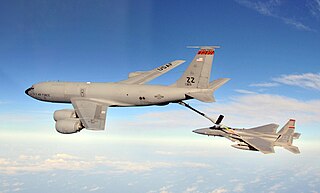
The Boeing KC-135 Stratotanker is a military aerial refueling aircraft that was developed from the Boeing 367-80 prototype, alongside the Boeing 707 airliner. It is the predominant variant of the C-135 Stratolifter family of transport aircraft. The KC-135 was the US Air Force's first jet-powered refueling tanker and replaced the KC-97 Stratofreighter. The KC-135 was initially tasked with refueling strategic bombers, but it was used extensively in the Vietnam War and later conflicts such as Operation Desert Storm to extend the range and endurance of US tactical fighters and bombers.

The Boeing RC-135 is a family of large reconnaissance aircraft built by Boeing and modified by a number of companies, including General Dynamics, Lockheed, LTV, E-Systems, and L3 Technologies, and used by the United States Air Force and Royal Air Force to support theater and national level intelligence consumers with near real-time on-scene collection, analysis and dissemination capabilities. Based on the C-135 Stratolifter airframe, various types of RC-135s have been in service since 1961. Unlike the C-135 and KC-135 which are recognized by Boeing as the Model 717, most of the current RC-135 fleet is internally designated as the Model 739 by the company. Many variants have been modified numerous times, resulting in a large variety of designations, configurations, and program names.
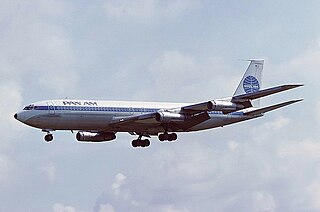
The Boeing 707 is a long-range narrow-body airliner produced by Boeing Commercial Airplanes, its first jetliner. Developed from the Boeing 367-80, a prototype first flown in 1954, the initial 707-120 first flew on December 20, 1957. Pan American World Airways began regular 707 service on October 26, 1958, and it was built until 1979. A quadjet, the 707 has a swept wing with podded engines. Its larger fuselage cross-section allowed six-abreast economy seating, retained in the later 720, 727, 737, and 757.

The Douglas DC-8 is a narrow-body airliner built by the American Douglas Aircraft Company. After losing the May 1954 USAF tanker requirement to the Boeing KC-135, Douglas announced in July 1955 its derived jetliner project. In October 1955, Pan Am made the first order along with the competing Boeing 707, and many other airlines followed. The first DC-8 was rolled out in Long Beach Airport on 9 April 1958 and flew for the first time on 30 May. FAA certification was achieved in August 1959 and the DC-8 entered service with Delta Air Lines on September 18.

Aerial refueling, also referred to as air refueling, in-flight refueling (IFR), air-to-air refueling (AAR), and tanking, is the process of transferring aviation fuel from one military aircraft to another during flight. The two main refueling systems are probe-and-drogue, which is simpler to adapt to existing aircraft, and the flying boom, which offers faster fuel transfer, but requires a dedicated boom operator station.

A jet airliner or jetliner is an airliner powered by jet engines. Airliners usually have two or four jet engines; three-engined designs were popular in the 1970s but are less common today. Airliners are commonly classified as either the generally long-haul wide-body aircraft or narrow-body aircraft.
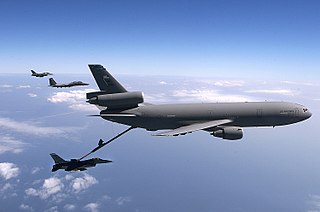
The McDonnell Douglas KC-10 Extender is an aerial refueling tanker aircraft operated by the United States Air Force (USAF). A military version of the three-engined DC-10 airliner, the KC-10 was developed from the Advanced Tanker Cargo Aircraft Program. It incorporates military-specific equipment for its primary roles of transport and aerial refueling. It was developed to supplement the KC-135 Stratotanker following experiences in Southeast Asia and the Middle East. The KC-10 was the second McDonnell Douglas transport aircraft to be selected by the Air Force following the C-9. A total of 60 KC-10s were produced for the USAF. The Royal Netherlands Air Force operates two similar tankers designated KDC-10 that were converted from DC-10s.

The Boeing C-97 Stratofreighter was a long-range heavy military cargo aircraft developed from the B-29 and B-50 bombers. Design work began in 1942, the first of three prototype XC-97s flew on 9 November 1944, and the first of six service-test YC-97s flew on 11 March 1947. All nine were based on the 24ST alloy structure and Wright R-3350 engines of the B-29, but with a larger-diameter fuselage upper lobe and they had the B-29 vertical tail with the gunner's position blanked off. The first of three heavily revised YC-97A incorporating the re-engineered wing, taller vertical tail and larger Pratt and Whitney R-4360 engines of the B-50 bomber, flew on 28 January 1948 and was the basis of the subsequent sole YC-97B, all production C-97s, KC-97s and civilian Stratocruiser aircraft. Between 1944 and 1958, 888 C-97s in several versions were built, 811 being KC-97 tankers. C-97s served in the Berlin Airlift, the Korean War, and the Vietnam War. Some aircraft served as flying command posts for the Strategic Air Command, while others were modified for use in Aerospace Rescue and Recovery Squadrons (ARRS).

The Airbus A310 MRTT Multi-Role Tanker Transport is a military air to air refuelling, or in-flight refuelling tanker transport aircraft, capable of operating multi-role missions. The A310 MRTT tanker aircraft is a subsequent development from the earlier Airbus A310 MRT Multi-Role Transport, which was a military transport aircraft for passengers, cargo, and medical evacuation. The A310 MRT and A310 MRTT are both specialist military conversions of existing airframes of the civilian Airbus A310-300C wide-bodied passenger jet airliner.

The Boeing C-135 Stratolifter is a transport aircraft derived from the prototype Boeing 367-80 jet airliner in the early 1950s. It has a narrower fuselage and is shorter than the 707. Boeing gave the aircraft the internal designation of Model 717. Since the first one was built in August 1956, the C-135 and its variants have been a fixture of the United States Air Force.
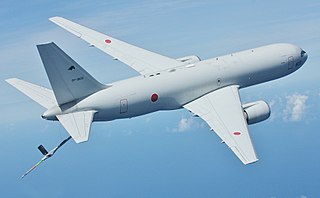
The Boeing KC-767 is a military aerial refueling and strategic transport aircraft developed from the Boeing 767-200ER. The tanker received the designation KC-767A, after being selected by the U.S. Air Force (USAF) initially to replace older KC-135Es. In December 2003, the contract was frozen and later canceled due to corruption allegations.

The Boeing 367-80, known simply as the Dash 80, is an American quadjet prototype aircraft built by Boeing to demonstrate the advantages of jet propulsion for commercial aviation. It served as basis for the design of the KC-135 tanker and the 707 airliner.
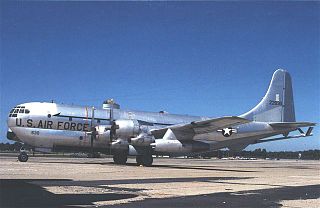
The Boeing KC-97 Stratofreighter is a United States strategic tanker aircraft based on the Boeing C-97 Stratofreighter. It was succeeded by the Boeing KC-135 Stratotanker.

The Boeing KB-29 was a modified Boeing B-29 Superfortress for air refueling needs by the USAF. Two primary versions were developed and produced: KB-29M and KB-29P.

The Boeing EC-135 is a retired command and control variant of the Boeing C-135 Stratolifter. During the Cold War, the EC-135 was best known for being modified to perform the Looking Glass mission where one EC-135 was always airborne 24 hours a day to serve as flying command post for the Strategic Air Command in the event of nuclear war. Various other EC-135 aircraft sat on airborne and ground alert throughout the Cold War, with the last EC-135C being retired in 1998. The EC-135N variant served as a tracking aircraft for the Apollo program.

The EADS/Northrop Grumman KC-45 was a proposed aerial refueling tanker aircraft based on the Airbus A330 MRTT. The United States Air Force (USAF) had ordered 179 KC-45As in the first stage of replacing the aging Boeing KC-135 Stratotanker tankers currently in service. However, the contest was reopened in July 2008, after Boeing's protest of the award was upheld. In response to the new contest, on 8 March 2010, Northrop Grumman announced it was abandoning its bid for the new contract, with its CEO stating that the revised bid requirement favoured Boeing. On 20 April 2010, EADS announced it was re-entering the competition and entered a bid with the KC-45. Eventually, the USAF selected the Boeing KC-46 Pegasus.

The 126th Air Refueling Squadron is a unit of the 128th Air Refueling Wing of the Wisconsin Air National Guard stationed at General Mitchell Air National Guard Base, Wisconsin. The 126th is equipped with the KC-135R Stratotanker.

The Boeing C-137 Stratoliner is a retired VIP transport aircraft derived from the Boeing 707 jet airliner used by the United States Air Force. Other nations also bought both new and used 707s for military service, primarily as VIP or tanker transports. In addition, the 707 served as the basis for several specialized versions, such as the E-3 Sentry AWACS aircraft. The designation C-18 covers several later variants based on the 707-320B/C series. The C-137 should not be confused with the superficially-similar Boeing C-135 Stratolifter; although they share a common ancestor the two aircraft have different fuselages.
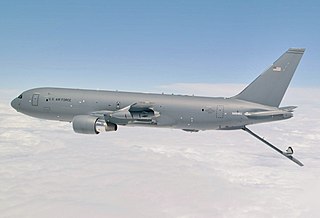
The Boeing KC-46 Pegasus is a military aerial refueling and strategic military transport aircraft developed by Boeing from its 767 jet airliner. In February 2011, the tanker was selected by the United States Air Force (USAF) as the winner in the KC-X tanker competition to replace older Boeing KC-135 Stratotankers. The first aircraft was delivered to the Air Force in January 2019. The Air Force intends to procure 179 Pegasus aircraft by 2027.




















